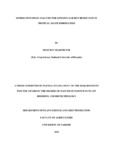| dc.description.abstract | Diplodia ear rot caused by Stenocarpella maydis (Berk) Sutton is one of the most important fungal diseases of maize in the tropics. Breeding programs in Eastern and Southern Africa have developed maize inbred lines with tolerance or resistance to Diplodia ear rot. Utilization of tolerant/resistant inbred lines in commercial hybrids or for further breeding requires knowledge of the inheritance of resistance Diplodia ear rot in this germplasm. The objectives of this study were to determine the mode of gene action, estimate heritability and heterosis for Diplodia ear rot resistance and agronomic traits through generation means analysis. Five inbred lines from Kenya and Mexico were crossed to form six F1 hybrids. Each F1 hybrid was self-pollinated to form the F2 and also backcrossed to each of the parental inbred lines. For each cross, six generations including the parental inbred lines (P1 and P2), F1, F2 and backcrosses (BC1P1 and BC1P2) were used to form six separate trials. Trials were arranged as a randomized complete block design (RCBD) replicated three times. Each plot consisted of 2 rows 4 m long, spaced 75 cm between rows and 20 cm within rows. The trials were evaluated at Kakamega, Alupe, and Kibos in western Kenya under artificial inoculation with Diplodia ear rot pathogen. Diplodia inoculum was raised at KARLO Kakamega Research Station. Inoculation of the top ear of each plant with Diplodia ear rot pathogen was done 18-20 days after mid-silk using the toothpick method. Agronomic traits (grain yield, days to anthesis, plant height, and ear aspect) and disease resistance parameters (Diplodia ear rot incidence and severity and weight of rotten ears) were recorded in the trials. Data were first subjected to analysis of variance and then generation mean analysis. Broad and narrow-sense heritability and heterosis were estimated for all the traits. Results showed that there were significant differences among generations for grain yield and other agronomic traits for all crosses. Combined analysis of variance revealed significant differences among generations for
xvii
Diplodia ear rot incidence, Diplodia ear rot severity and weight of rotten ears in some crosses.
Generation means for grain yield fitted an additive-dominance model in five crosses while generation means for other agronomic traits (days to anthesis, plant height and ear aspect) did not fit an additive-dominance model suggesting a more complex model including epistasis for these traits. The generation means for Diplodia ear rot severity and weight of rotten ears fitted an additive-dominance model in all crosses while a complex model was needed to fit the generation means for Diplodia ear rot incidence. The magnitude of dominance effects was much higher compared to additive effects suggesting greater importance of dominance gene effects relative to additive gene effects in control of inheritance of grain yield. There was preponderance of dominance effects over additive effects for the other agronomic traits. Presence of significant additive x additive [aa] and dominance x dominance [dd] epistatic effects was detected for ear aspect and plant height, respectively. There was variable importance of additive gene effects for Diplodia ear rot incidence and severity among the crosses. Five and four crosses showed significant additive effects for Diplodia ear rot incidence and Diplodia ear rot severity, respectively. All the significant additive effects for Diplodia ear rot incidence and severity were negative. Dominance in this set of crosses was in the direction of greater resistance. The results for weight of rotten ears showed that the dominance effects were positive and significant for five out of the six crosses. For most crosses, these results implied the importance and prevalence of additive mode of gene action for resistance to Diplodia ear rot. The prevalence of additive mode of gene action in the majority of crosses in study suggests that selection among inbred lines under artificial inoculation with Diplodia ear rot should be effective. Both Diplodia ear rot and severity reaction of the parental inbred lines should be a reliable indicator of disease reaction of their hybrids. The identification of some inbred lines like CML543 and LPSC7 with fairly good
xviii
levels of tolerance to Diplodia ear rot offers breeding programs in the region an opportunity to include these lines in their inbred line development programs. Some of the inbred lines used in this study like CML543, LPSC7 and VL06688 and other resistant inbred lines should be used for S. maydis resistance quantitative trait loci (QTL) validation and genome-wide association studies (GWAS) for detailed investigation of the genetics of Diplodia ear rot resistance in tropical maize for possible implementation of a marker-assisted breeding for this disease. Broad-sense and narrow-sense heritability estimates for grain yield were moderate to high for most of the crosses. Broad-sense heritability estimates for Diplodia ear rot incidence and severity were mostly low suggesting that the environment had a larger effect compared to the genotype. Relatively high narrow-sense heritability estimates for Diplodia ear rot incidence severity were obtained which suggested that resistance to Diplodia ear rot can be improved fairly quickly in this set of lines. Heterosis estimates were much larger for grain yield compared to other traits. Heterosis for the two disease parameters was negative in four out of the six crosses, which suggested that the F1 hybrids tended to have lower diseases ratings than some of the parents. | en_US |



